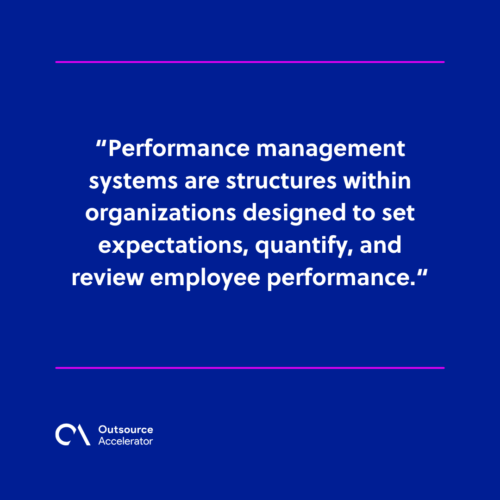All you need to know about performance management systems (with examples)

Efficiency is what keeps businesses from tanking. Efficient companies thrive, and thriving companies prosper.
But how do organizations gain and maintain efficiency? By using effective performance management systems, of course!
If you work in the human resources (HR) field, you may already be familiar with this term. But for business owners with no prior experience with performance management, this article can serve as your guide.
Read on to start learning!
What is a performance management system?
As the term implies, performance management systems are structures within organizations designed to set expectations, quantify, and review employee performance.
There are many types of systems used for performance management in different companies. However, each system typically involves a combination of informal employee check-ins and formal reviews that follow a regular schedule.
Regardless of the type of performance management system a business uses, they all share common objectives:
1. Establish an ideal, acceptable, and expected performance level for employees.
2. Assess how well workers are performing by measuring their efficiency against the established and expected metrics.
3. Find areas of improvement based on the results.

4 Types of performance management systems
Different organizations have varying needs, processes, and priorities. This means they also have different definitions of and ways to measure workplace efficiency.
Here are examples of performance management systems companies often use:
Balanced Scorecard
For businesses needing to measure performance across several areas, the Balanced Scorecard is the preferred tool.
You can think of the Balanced Scorecard as similar to a report card for employees. Instead of showing the marks for just a single area, this type of performance management system shows how well a particular worker performed in the different aspects of their job.
Suppose that the employee being assessed works at a call center agency. Some of the common metrics used to measure performance in this case include average handle time (AHT) and agent utilization rate.
Rather than determining how good an agent is at their job by looking at just one metric (e.g., AHT), companies that use the Balanced Scorecard quantify worker performance by averaging scores across multiple categories with different assigned weights.
This leads to a more comprehensive and balanced measurement of employee efficiency.
360-degree Feedback System
While the Balanced Scorecard measures worker performance across key areas, the 360-degree Feedback System uses anonymous feedback from different people as the basis for evaluation.
It’s important to note that the inputs used for this appraisal system are from people with whom the evaluated employee has a professional relationship.
This provides a rounded (hence the term 360-degree) and multifaceted insight into a worker’s skills and behavior.
This method of performance assessment is more qualitative than quantitative. As such, the 360-degree Feedback System can be more helpful in measuring “soft” skills, such as:
- Character
- Collaboration
- Leadership
- Overall workplace behavior
HR personnel often use questionnaires, surveys, or feedback forms to carry out this type of performance evaluation.
Objectives and Key Results (OKR)
The Objectives and Key Results framework is one of the most widely used performance management systems among businesses.
It provides organizations with a straightforward way to track and measure performance systematically.
OKR has two dimensions: Objectives and key results. Objectives refer to the goals organizations set for employees that must be achieved within a given timeframe.
On the other hand, key results pertain to the quantified and measurable outcomes that will determine whether workers have met the set objectives.
OKR assessments are often conducted quarterly, but can be done even more frequently depending on the company.
Despite sounding similar to Key Performance Indicators (KPI), the two shouldn’t be conflated. Both measure specific metrics, but KPI is more focused on tracking performance, while OKR is concerned with setting and achieving goals.
Management by Objectives (MBO)
Similar to OKR, Management by Objectives is another performance management system that sets goals employees must achieve.
What sets MBO apart from OKR is that it does not have clearly defined key results. Instead, MBO focuses on the bigger picture (i.e., the set goal).
This means that organizations that measure employee performance using the MBO framework are more concerned with whether objectives have been satisfied than with how these goals were reached.
For instance, a company using the MBO system can set “Improve Customer Experience” as an objective.
If the OKR framework were used instead, the goal would be more delineated and would include specific and measurable metrics that can help indicate if employees are achieving the objective, such as:
- Increased Net Promoter Score from 0 to 85
- Achieve post-service CX survey scores of 90% or higher
- Reduce customer service response time to under 1 hour
Core components of performance management systems
Despite the variety of performance management systems organizations can choose from, these productivity-measuring mechanisms share basic components:
Planning and goal setting
Establishing clear goals and expectations is crucial to the success of any performance management system.
By setting the goalposts early on, employees will have a solid idea of what they should be striving for and have an idea of how well they are doing.
Objectives should always be SMART, or:
- Specific: Employees must know exactly what the goal is (e.g., reduce AHT)
- Measurable: It must be possible to quantify the goal (e.g., reduce AHT by a given percentage)
- Achievable: It must be attainable (e.g., reduce AHT by 20%)
- Realistic: The goal must be relevant to the employee’s role (e.g., reduce AHT by 20% for agents handling inbound calls)
- Time-bound: There should be a specific period of assessment to see whether the worker has achieved the objective (e.g., reduce AHT by 20% within the next 3 months)
Constant communication
Keeping regular communication helps ensure that everyone is on the same page when it comes to achieving organizational objectives and performance expectations.
Moreover, open communication among workers and higher management improves morale by promoting a culture of transparency.

Performance appraisal
Performance reviews are the whole point of performance management systems.
These evaluations help managers pinpoint areas of improvement and devise plans to help employees improve skills where they are lacking.
Performance appraisals are a good time to set new goals and outline new priorities.
Rewards and recognition
For workers who go above and beyond in their jobs, performance management systems can serve as tools to get them noticed by management.
These evaluation systems can help managers recognize and reward employees with exemplary work ethics and efficiency.
Often, salary increases and other monetary incentives are anchored on the results of these appraisals.
Feedback and suggestions
Performance appraisals are a continuous source of feedback that provides team members and managers with an overview of their work efficiency.
This consistent feedback works in two ways. Firstly, it acknowledges the efforts of high-performing employees.
Second, it also provides actionable insights into their professional development and which areas management needs to focus on to further improve overall organizational effectiveness.
Role of HR in performance management
Human resource personnel have a multifaceted role in employee performance management. They help maintain the consistency and reliability of assessment tools to ensure fairness to all employees.
HR is also responsible for helping managers learn best practices for performance management through coaching sessions.
Perhaps most importantly, it falls upon HR to ensure that employees remain motivated to achieve their objectives and that individual goals align with those of the organization.
Performance management systems: Examples of case use
If you’re still unsure about how organizations use performance management systems, here are some examples that illustrate them:
- MBO: A manager gives a sales agent the goal to increase their Q2 sales revenue. It’s inessential how the sales rep does this; what matters is whether they’ll hit the objective or not.
- OKR: A senior developer was given the objective of improving the user experience of their company’s mobile app. The objective has three key results to measure success: (1) reduce the app crash rate by 30%, (2) launch redesigned navigation by the end of Q2, and (3) increase app store rating from 4.2 to 4.5.
- 360-Degree Feedback: A top-performing employee being considered for promotion to a managerial role undergoes a 360-degree feedback evaluation to assess if their skills align with what HR expects from managers.
Which performance management system is the best?
Each system for managing performance has its strengths and weaknesses. When choosing which performance management framework would work best for your company, consider how your organization thinks about strategy.
For instance, if your company is powered by individual departments with different goals, Management by Objective can be a solid choice.
However, if your organizational structure relies on cross-functional teams and company-wide collaborations, the Objectives and Key Results framework is likely a better alternative as it promotes shared goals across different departments.
If you’re keen on improving your business’s organizational efficiency through performance management, hiring a performance manager can be a good idea.







 Independent
Independent




